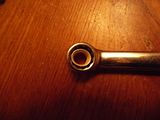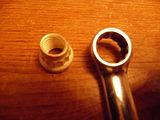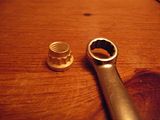yourguitarhero wrote:
What's special about k nuts?
The holes are not round, so they are self locking for high temperatures. Generally, the hex heads (or double hex heads) are smaller (for 5/16 UNF a HD exhaust nut has a 1/2 AF hex whereas a K nut has a 3/8 AF hex).
All jet engines are built with them cos you can't really afford for things to vibrate loose. The type used in high temperature areas are silver plated for corrosion resistance cos when the engine comes into the workshop, you want to be able to get it apart.
These double hex nuts work with a standard 3/8 AF 12 point socket.
http://cgi.ebay.co.uk/Pack-5-5-16-UNF-A ... 1e62415bfbSome more info I posted for our American cousins here:
http://www.badweatherbikers.com/buell/m ... 10312.htmlQuote:
I use these, on a 1/4" extension, to tighten/loosen the nuts:

And these (K Nuts) as the nuts as they are actually not round, but a curved triangle, making them self locking and resistant to vibration:

The cool thing about these is that they are 3/8 AF rather than 1/2 AF meaning that you have more room for the socket...
The torque setting in the manual is 72-96 inch-lbs, which is very low. The result of putting too much torque on these nuts is to squash your exhaust gasket and give the gas a smaller hole to flow through, which of course will lose you power. The ideal torque is just enough to allow the header to seal on gasket.
The interesting thing about the studs is that they appear to be 5/16 UNF one end (the nut end) and 5/16 UNC on the head end. However... it is a variation of 5/16 UNC on the head end as although the major diameter and pitch are as you would expect, the minor diameter and thread angle are bigger. Don't know what I am talking about? Try running a nut down the coarse end... Anyway, as you have guessed, the large minor diameter interferes with the thread in the head to give the stud self locking properties...
And, finally, always use copa slip on the threads to give the nut the best chance of removal. The same goes for the stud when you replace it.
and
Quote:
Here is a photo of spanner (wrench) and nut. They are the same fitting...



These are ovalised at the end rather than being triangulated (as the 6 sided ones are) and are silver plated as the silver acts as a high temperature dry lubricant...
http://www.ret-monitor.com/articles/1341/silver-pl ating-of-fasteners/







